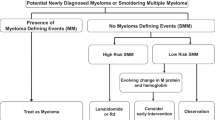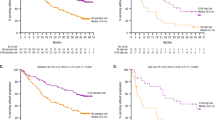Abstract
We conducted a clinical trial of thalidomide as initial therapy for asymptomatic smoldering (SMM) or indolent multiple myeloma (IMM). Sixteen patients were studied. Thalidomide was given orally at a dose of 200 mg/day for 2 weeks, and then increased as tolerated by 200 mg/day every 2 weeks to a maximum dose of 800 mg/day. Bone marrow microvessel density (MVD) and angiogenesis grading were estimated using CD34 immunostaining. Six patients had a confirmed response to therapy with at least 50% or greater reduction in serum and urine monoclonal (M) protein. When minor responses (25–49%) decrease in M protein concentration) were included, 11 of 16 patients (69%) responded to therapy. Major grade 3–4 toxicities included two patients with somnolence, and one patient each with syncope and neutropenia. Pre-treatment MVD was not a significant predictor of response to therapy, median MVD 4 and 12 in responders and non-responders respectively, P = 0.09. We conclude that thalidomide has significant activity in the treatment of newly diagnosed SMM/IMM. However, we do not recommend treatment with thalidomide at this stage since some patients with SMM/IMM can be stable for several months or years without any therapy. Additional randomized trials are needed to determine if thalidomide will delay progression to active multiple myeloma.
This is a preview of subscription content, access via your institution
Access options
Subscribe to this journal
Receive 12 print issues and online access
$259.00 per year
only $21.58 per issue
Buy this article
- Purchase on Springer Link
- Instant access to full article PDF
Prices may be subject to local taxes which are calculated during checkout
Similar content being viewed by others
References
Greenlee RT, Murray T, Bolden S, Wingo PA . Cancer statistics, 2000 CA Cancer J Clin 2000 50: 7–33
Bataille R, Harousseau JL . Multiple myeloma N Engl J Med 1997 336: 1657–1664
Greipp PR, Kyle RA . Staging, kinetics, and prognosis of multiple myeloma In: Wiernik PH, Canellos GP, Dutcher JP, Kyle RA (eds) Neoplastic Diseases of the Blood New York: Churchill Livingstone 1996 pp 537–559
Kyle RA, Greipp PR . Smoldering multiple myeloma N Engl J Med 1980 302: 1347–1349
Vacca A, Ribatti D, Roncali L, Ranieri G, Serio G, Silvestris F, Dammacco F . Bone marrow angiogenesis and progression in multiple myeloma Br J Haematol 1994 87: 503–508
Rajkumar SV, Leong T, Roche PC, Fonseca R, Dispenzieri A, Lacy MQ, Lust JA, Witzig TE, Kyle RA, Gertz MA, Greipp PR . Prognostic value of bone marrow angiogenesis in multiple myeloma Clin Cancer Res 2000 6: 3111–3116
Rajkumar SV, Witzig TE . A review of angiogenesis and anti-angiogenic therapy with thalidomide in multiple myeloma Cancer Treat Rev 2000 26: 351–362
Singhal S, Mehta J, Desikan R, Ayers D, Roberson P, Eddlemon P, Munshi N, Anaissie E, Wilson C, Dhodapkar M, Zeddis J, Barlogie B . Antitumor activity of thalidomide in refractory multiple myeloma N Engl J Med 1999 341: 1565–1571
Rajkumar SV, Fonseca R, Dispenzieri A, Lacy MQ, Lust JA, Witzig TE, Kyle RA, Gertz MA, Greipp PR . Thalidomide in the treatment of relapsed multiple myeloma Mayo Clin Proc 2000 75: 897–902
D'Amato RJ, Loughnan MS, Flynn E, Folkman J . Thalidomide is an inhibitor of angiogenesis Proc Natl Acad Sci USA 1994 91: 4082–4085
Kenyon BM, Browne F, D'Amato RJ . Effects of thalidomide and related metabolites in a mouse corneal model of neovascularization Exp Eye Res 1997 64: 971–978
Rajkumar SV, Fonseca R, Witzig TE, Gertz MA, Greipp PR . Bone marrow angiogenesis in patients achieving complete response after stem cell transplantation for multiple myeloma Leukemia 1999 13: 469–472
Kneller A, Raanani P, Hardan I, Avigdor A, Levi I, Berkowicz M, Ben-Bassat I . Therapy with thalidomide in refractory multiple myeloma – the revival of an old drug Br J Haematol 2000 108: 391–393
Juliusson G, Celsing F, Turesson I, Lenhoff S, Adriansson M, Malm C . Frequent good partial remissions from thalidomide including best response ever in patients with advanced refractory and relapsed myeloma Br J Haematol 2000 109: 89–96
Rajkumar SV, Fonseca R, Witzig TE, Gertz MA, Greipp PR . Bone marrow angiogenesis in patients achieving complete response after stem cell transplantation for multiple myeloma Blood 1998 92: (Suppl. 1) 99a
Munshi N, Wilson CS, Penn J, Epstein J, Singhal S, Hough A, Sanderson R, Desikan R, Siegel D, Mehta J, Barlogie B . Angiogenesis in newly diagnosed multiple myeloma: poor prognosis with increased microvessel density (MVD) in bone marrow biopsies Blood 1998 92: (Suppl. 1) 98a
Moreira AL, Sampaio EP, Zmuidzinas A, Frindt P, Smith KA, Kaplan G . Thalidomide exerts its inhibitory action on tumor necrosis factor alpha by enhancing mRNA degradation J Exp Med 1993 177: 1675–1680
Haslett PA, Corral LG, Albert M, Kaplan G . Thalidomide costimulates primary human T lymphocytes, preferentially inducing proliferation, cytokine production, and cytotoxic responses in the CD8+ subset J Exp Med 1998 187: 1885–1892
Geitz H, Handt S, Zwingenberger K . Thalidomide selectively modulates the density of cell surface molecules involved in the adhesion cascade Immunopharmacology 1996 31: 213–221
Acknowledgements
This work was supported by Grants CA85818 and CA62242 from the National Cancer Institute, Bethesda, MD. SVR and RF are supported in part by Leukemia and Lymphoma Society Translational Research Awards. SVR is also supported by the Judith and George Goldman Foundation Fighting Catastrophic Diseases, Lake Forest, Illinois, USA.
Author information
Authors and Affiliations
Rights and permissions
About this article
Cite this article
Rajkumar, S., Dispenzieri, A., Fonseca, R. et al. Thalidomide for previously untreated indolent or smoldering multiple myeloma. Leukemia 15, 1274–1276 (2001). https://doi.org/10.1038/sj.leu.2402183
Received:
Accepted:
Published:
Issue Date:
DOI: https://doi.org/10.1038/sj.leu.2402183
Keywords
This article is cited by
-
Phase III randomized trial of Thal+ZLD versus ZLD in patients with asymptomatic multiple myeloma – updated results after 18-year follow-up
Leukemia (2024)
-
CD4+CD25+ cells in multiple myeloma related renal impairment
Scientific Reports (2015)
-
Hyperlipidemic myeloma: review of 53 cases
Annals of Hematology (2010)
-
Therapeutic renaissance of thalidomide in the treatment of haematological malignancies
Leukemia (2005)
-
The combination of intermediate doses of thalidomide with dexamethasone is an effective treatment for patients with refractory/relapsed multiple myeloma and normalizes abnormal bone remodeling, through the reduction of sRANKL/osteoprotegerin ratio
Leukemia (2005)



